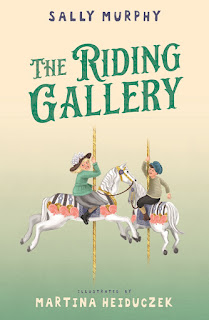Tell me about this merry-go-round: It was the largest portable steam riding gallery seen in Australia, with a mechanical system allowing it to carry fifty tons without noise or vibration. It carried forty-eight ornately carved horses galloping four abreast; a steam-engine of brass against a highly decorative mirrored background; twisted brass upright bars and an elaborate organ with moving mechanical figures. The carved wooden horses, imported from Germany were impaled on brass bars made in Scotland. They were brightly painted with coloured glass on their harnesses and gargoyles on the rear of their saddles. The horses were all named after popular racehorses of the time.
The carousel and organ were installed on the Esplanade of the Melbourne bay side suburb of St. Kilda adjacent to Luna Park, the recently built (December 1912) amusement park modelled on a similar American establishment at Coney Island. The carousel travelled the rural “show circuit” during the winter months for a number of years, before being located permanently on the Esplanade at St.Kilda. Anton Weniger, a German immigrant ran the carousel until he relinquished it to William Kelly after about fifty soldiers arrived at the Esplanade in January 1916 during the First World War and attacked Weniger’s Riding Gallery because he was German. (from “St.Kilda - The Show Goes On” by Anne Longmire, 1983). It is likely that the organ facade was damaged at this time since the maker’s name (Gebruder Bruder) was emblazoned on it above the Glockenspiel. The board bearing the maker’s name and the wings, which carried the drums, are missing from those parts of the facade that still exist. Source
You can see the merry-go-round here in Canberra.
More background information: The story begins with Herbert Thomson, born in Melbourne in 1890. By age 19, he had helped his father install machines in coal mines and built a steam engine used in a boat launch on the Yarra River. By 27, he had set up his own business producing steam engines and boilers. In July 1899, he revealed his tour de force – a self-propelled, steam-driven vehicle – or, to put it another way, Australia’s first car. It reached a top speed of 24 km/h, hit during a 56 hour, 36 minute maiden journey from Bathurst to Melbourne. The Thomson Motor Car Company was born, and subsequent models reached 40 km/h and even beat a Benz imported from Germany. The company went out of business in 1912, but not before Herbert had designed a steam-powered carousel for St Kilda beach. It was a properly international effort. The animals, including 50 horses and two elephants, were hand carved in Germany, and sit four abreast in 14 rows, while the twisted brass poles were made in Scotland. Jaunty accompaniment was taken care of by a steam-powered 69-key pipe organ, also from Germany. It drew crowds in Melbourne until September 1973, when Canberra locals collectively raised $40,000 to purchase it from a public auction. Source
Listen to this ABC interview with Sally Murphy.
My friend tells me this book will be welcomed in our New South Wales schools because one of the 'set texts' for the English syllabus is Worse Things by Sally Murphy - sorry I have not been able to find the unit of work but she explained how she creates sets of books for classrooms filled with books to further extend these prescriptive English units containing books by the author being studied or books from a related genre or theme. I hope you can hear me cheering her hard work.
Here are some other books by Sally Murphy I have talked about on this blog:
Other books about Merry-go-rounds:











No comments:
Post a Comment